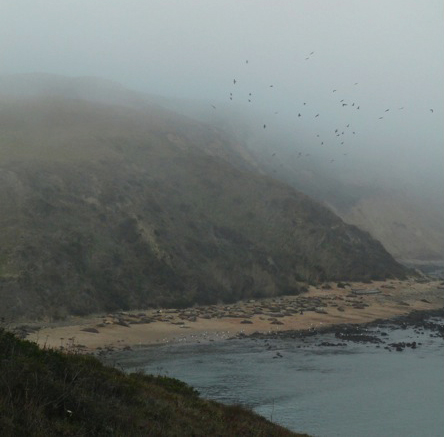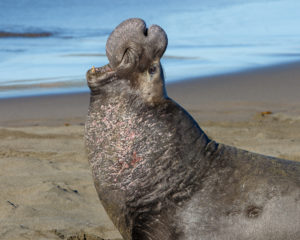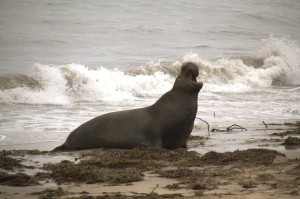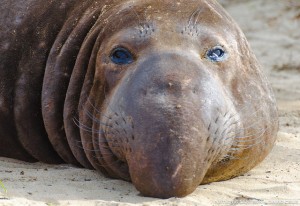Thousands of elephant seals have descended on Pacific coast beaches to partake in their annual mating rituals. The squabbling colonies are well noted by tourists, and also a variety of non-human species that see a dining opportunity in the mass of beached blubber.
“When elephant seals haul in they provide a lot of food in terms of dead pups, placentas, and even milk,” said Frank Balthis, a ranger at Año Nuevo State Park, one of the major breeding sites on the Northern California coast.
It stands to reason that the normally low-key beaches at Año Nuevo State Park and Point Reyes Natural Seashore would be dramatically altered – at least temporarily – by the arrival of so many of these hefty, sea-faring mammals.
Weighing in at up to 5,000 pounds, elephant seals haul themselves ashore twice a year. In the fall, they come to molt. Unlike other mammals which continually lose and renew skin and hair throughout the year, elephant seals and other pinnipeds do so all at once. They come again from December to March to give birth and mate, creating large colonies with a hierarchical social system.
As the large alpha males battle it out to gain dominance over harems of females, newborn pups are often crushed in the chaos. According to some estimates, up to 10% of pups born during the breeding season may die in this manner. Other pups die after being separated from their mothers, or from being thrown against rocks or swept out to sea during rough weather.
The loss of life is surely sad. But it’s a natural part of the food chain for other animals and their young. Carrion birds, such as turkey vultures, as well as omnivorous ravens and gulls, all benefit from the rare bump in the food supply. Coyotes, too, have been known to feed off the young elephant seals.
Scavengers make out not only in death, but in birth as well, when placenta from the newborn pups scatter high concentrations of nutrients ashore. Huge flocks of gulls gather above the breeding grounds in anticipation of a birth.
Due to their high concentration of fat, elephant seals are also a favorite of great white sharks, according to Balthis. Mostly, the shark attacks occur in the fall molting months, before the sharks move off to warmer waters for the winter.
The elephant seals’ arrival is not good news for all. Due to habitat loss, the elephant seals are sometimes forced into competition with other species for limited protected beachfront. At particular risk is the western snowy plover, a threatened species that nests on open beaches, and some native plant species. The nests and plants can easily be disturbed or crushed by the lumbering seals.
All in all, the burgeoning colonies offer a rare and intimate look at these normally sea-faring pinnipeds. The picture isn’t all pretty, but it’s the cycle of life and death on display for those who dare to look closely.
To check out the elephant seals at Año Nuevo State Park, make your reservation for a ranger-guided walk here.
Information on viewing elephant seals at Point Reyes is here.

.jpg)




